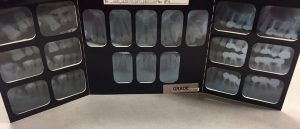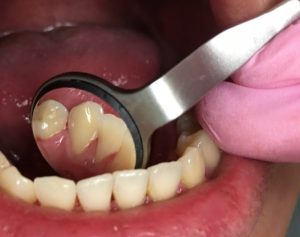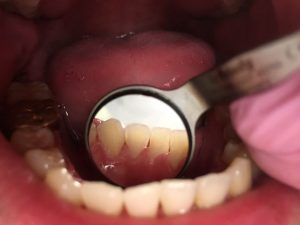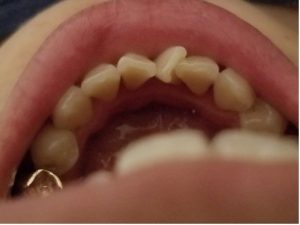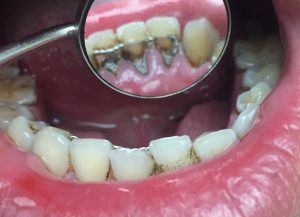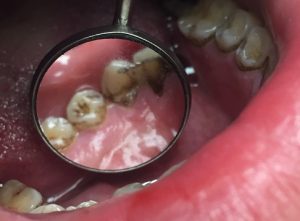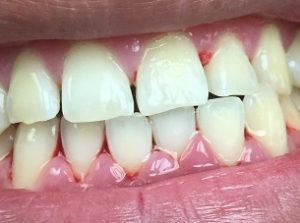Case #1.
The patient is a 35 years old, Asian female. No significant findings on medical history to report and no medications were currently being taken. The patient’s last prophylaxis was done in 2011. She presented with moderate to heavy localized supragingival calculus on anterior lingual aspects of the mandible and subgingival calculus on all molars. Gingiva was generalized spongy, red and inflamed with rolled margins. The patient had 4-6mm pockets, 6mm present on interproximal of molars. A full mouth series of radiographs was exposed to detect bone loss and more than 3mm bone loss was present on lower anterior region. No mobility was present.
Scaling/Root planning was performed which took three visits to complete. No fluoride varnish was given due to absence of risk for caries and sensitivity/recession. Based on the assessment, the use of Listerine Antiseptic was recommended to reduce the amount of bacteria in the mouth and help shrink the tissue. Correct brushing technique; modified bass brushing technique and flossing was demonstrated and instructed. Three months recare was recommended.
Before
After
Case #2.
The patient is 24 years old, Asian male. No significant findings on medical history to report and no medications were currently being taken. The patient did not recall when he had last prophylaxis and radiograph exposure. The patient is neither a smoker nor a coffee/tea drinker but presented with generalized heavy staining. He stated that his foods consumption is primarily soy sauced based, which may explain excessive staining. The patient had lingual bars where plaque and calculus were accumulated the most and also presented with heavy generalized supragingival and subgingival calculus. Gingival tissue was slightly red, spongy, bulbous and marginally rolled without stippling. The patient had 4-6mm pockets, 6mm present on interproximal of molars. Bws was exposed to detect crestal bone loss, caries, and calculus and we have not detected any one of those.
Prophy-jet was performed to remove heavy staining in addition to Scaling/Root planning using Ultrasonic and hand instruments which took two visits to complete. No fluoride varnish was given due to absence of a risk for caries and sensitivity/recession. Based on the assessment, brushing two times daily using soft bristle toothbrush with circular motion was recommended and demonstrated to reduce plaque accumulation. Circular brushing technique was recommended instead of modified bass brushing technique because the patient wanted an easier brushing technique. The use of Listerine antiseptic mouth rinse was also recommended to reduce inflamed gingiva, especially on the lower anterior region. Three months recare was recommended.
Before
After
Case #3.
The patient is 20 years old Pakistan decent, male. No significant findings on medical history to report and no medications were currently being taken. The patient had last prophylaxis about three years ago. The patient presented with heavy supragingival calculus on all teeth with moderate subgingival calculus on all molars. Moderate to heavy staining was present on all lingual aspects of all teeth due to drinking the excessive amount of black tea. Gingival tissue was pinkish-red, slightly spongy with rolled margins. Moderate inflammation was present on all molars. The patient had 4-5mm pockets mostly on interproximal of all molars. No radiograph was taken due to patient’s desire to have it exposed at his private dental office. Before scaling, my professor advised me to use hydrogen peroxide as well as a course prophy-paste to achieve a better end result. Using ultrasonic and hand instruments, I was able to remove all of the stains in two visits. Based on the assessment, informed a patient of the importance of flossing two times daily before brushing to remove debris and plaque interproximally, since pockets were present mostly in those areas. No fluoride varnish was given due to the absence of risk for caries and sensitivity/recession. Three months recare was recommended.
Before
After
Cast study #4- Arestin (No picture)
The patient is 38 years old African American, female. No significant findings on medical history to report and no medications were currently being taken. The patient had last prophylaxis and radiograph exposure in 2016. The patient is a nonsmoker. She presented with moderate localized supragingival calculus on anterior lingual aspects of the mandible and subgingival calculus on all molars. Gingiva was generalized spongy, pinkish red and inflamed with rolled margins. The patient had 4-6mm pockets, 6mm pocket was present on tooth #2(M) and #3(D) had probing depth of 5mm. The patient already had full mouth series radiograph with her and about 3mm bone loss was present around tooth #2 and #3. No mobility was present.
Scaling/Root planning using hand instruments and ultrasonic was performed which took two visits to complete. No fluoride varnish was given due to absence of risk for caries and sensitivity/recession. Based on the assessment, the use of Listerine Antiseptic was recommended to reduce the amount of bacteria in the mouth and help shrink the tissue. Informed a patient of the importance of flossing two times daily before brushing to remove debris and plaque interproximally, since pockets were present mostly in those areas. Three months recare was recommended. Two weeks after completion of scaling/Root planning, the patient came back for the Arestin placement. Before placement, I checked probing depths of tooth #2 and #3 to see if there is any tissue shrinkage after scaling/Root planning, but probing readings were the same. I placed the Arestin successfully with the help of my professor and post operative instructions were given to the patient. After about a month, the patient came back for evaluation of those areas. and pockets depths were significantly reduced. Tooth #2(M) went from 6mm to 4mm and tooth #3(D) went from #5mm to #3mm. The result was successful and patient was very happy about it. The importance of oral hygiene and home care was emphasized again to the patient.


